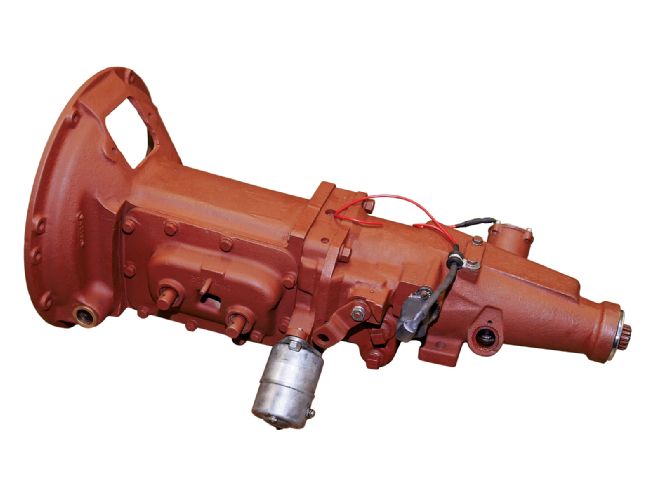
Before overdrive automatics and five- and six-speed sticks became common, there was another way to get a tall top cog for highway cruising: a Borg-Warner overdrive behind a three-speed manual transmission. First introduced in '34 Chryslers and DeSotos, they were subsequently used by most Chrysler products and practically every other manufacturer, including Ford, GM, Hudson, Kaiser/Frazier, Packard, Studebaker, Willys, the list goes on. The Blue Oval bunch had an affinity for the B-W overdrive and first offered it in the Lincoln/Zephyr in 1941. It became optional on Ford and Mercury cars from 1949, and it faded from the scene in cars as the '60s came to a close. Ford pickups continued to offer overdrive into the '70s.
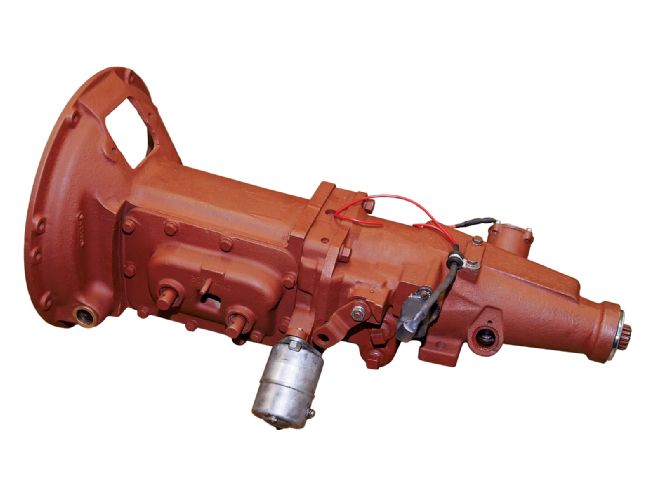 Borg-Warner overdrives were found behind a variety of three-speed manual transmissions and while this transmission is typical of those found in '49 to early '51 Mercurys, the process for rebuilding any three-speed overdrive is similar. Note this transmission has the pre-'49 Ford-style bellhousing so it will bolt to an early Flathead. The round canister is the overdrive solenoid. As all B-W electrical components are interchangeable, we installed a later-model 12-volt solenoid.
Borg-Warner overdrives were found behind a variety of three-speed manual transmissions and while this transmission is typical of those found in '49 to early '51 Mercurys, the process for rebuilding any three-speed overdrive is similar. Note this transmission has the pre-'49 Ford-style bellhousing so it will bolt to an early Flathead. The round canister is the overdrive solenoid. As all B-W electrical components are interchangeable, we installed a later-model 12-volt solenoid.
Relatively compact, the B-W unit used a planetary gear set that fit in between the transmission and the tailshaft housing and offered a .70:1 ratio (.72:1 for the R-11) overdrive that was available in Second and Third gear, effectively offering five forward speeds: First, Second direct, Second overdrive, Third direct, and Third overdrive.
Operating the overdrive is simple enough-a dashboard-mounted cable control is used by the driver to manually put the transmission in or out of overdrive mode. Pulling the handle out takes the transmission out of overdrive and operates like a conventional three-speed. Pushing the handle in engages the overdrive and an electrical control system consisting of a solenoid, governor, and kick-down switch, take care of actual shifting.
Driving a car with overdrive does require you to understand the system's operation and may require some adjustment in driving style. With the overdrive engaged (handle in), the transmission will freewheel below 20-32 mph (depending on the car's rearend gearing), which means the engine will drive the wheels, but when you lift off the throttle the wheels won't spin the engine-the car will coast as there is no engine braking. However, once the car is up to the required miles per hour, the governor closes the electrical circuit, then when the driver momentarily releases the throttle the solenoid locks the sun gear of the planetary set and the transmission shifts into overdrive (which also means there will be compression braking when you let off the gas). Shifting out of overdrive happens one of two ways: slowing down under the governor cut-in speed causes the solenoid to release. Or, if the throttle is floored the kick-down switch is activated. This does two things; it interrupts power to the solenoid and the ignition circuit momentarily. With power to the solenoid cut you would think it would release the sun gear and the transmission would revert to direct drive. But under load the solenoid pin is "trapped" and can't release, so shutting down the ignition system briefly (it's said to be one or two crankshaft revolutions) the load on the solenoid pin is released, it immediately withdraws releasing the sun gear (which means the transmission is in direct drive) and the ignition system is back on all in the blink of an eye.
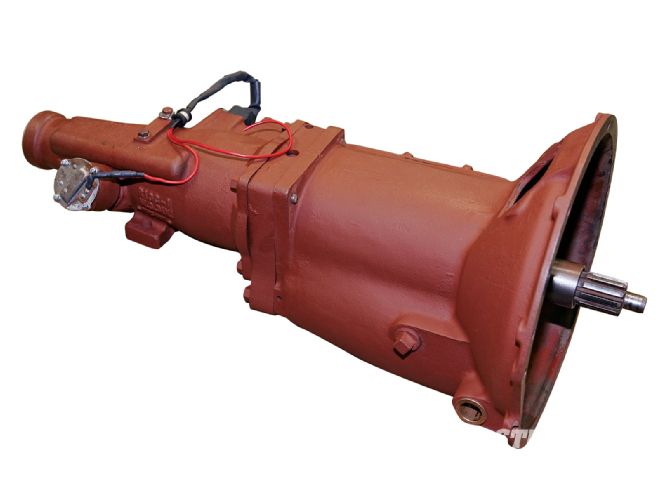 On the right side of the tail housing is the governor. It's driven off the speedometer gear and is not voltage sensitive, so it will work with 6 or 12.
On the right side of the tail housing is the governor. It's driven off the speedometer gear and is not voltage sensitive, so it will work with 6 or 12.
Thanks to the governor, the transmission will go into overdrive once cut-in speed is achieved, so around town in traffic using overdrive in Second gear is a natural-it's like having an automatic to a certain extent as the transmission will shift back and forth between direct and overdrive as the speed dictates. On the highway, cruising in Third overdrive and stomping on the gas pedal will cause a downshift to direct for passing.
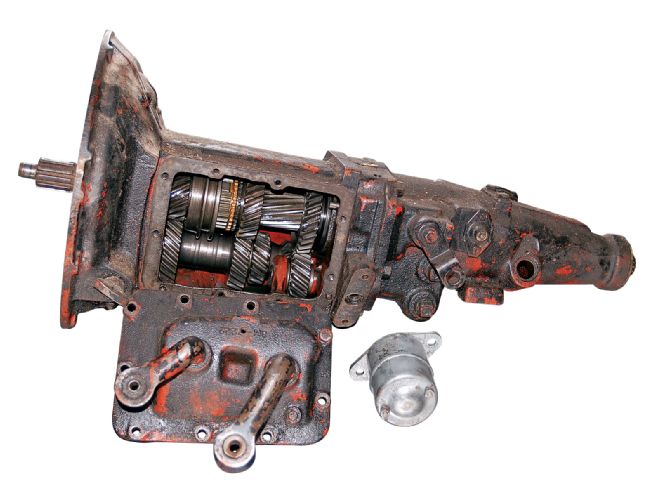 Although our transmission came out of a running car and was reported to be in good working order, we elected to look inside-good thing as some bearings were due to be replaced and new synchronizers were deemed to be a worthwhile investment.
Although our transmission came out of a running car and was reported to be in good working order, we elected to look inside-good thing as some bearings were due to be replaced and new synchronizers were deemed to be a worthwhile investment.
One other peculiarity of these overdrives should be noted. When left in overdrive mode, more than one parked car has been known to roll away. Most transmissions had an internal mechanism to lock out overdrive in reverse, which would keep this from happening, but the only other way to keep the car from rolling in any other gear was to disengage overdrive and make sure the parking brake was operational.
During its production life, two versions of the B-W overdrive were built: the R-10 and the R-11. The R-10 had a three-pinion planetary gear set and was adequate for most street applications while the R-11 used four pinions and was tougher in general. In fact, coupled with a T-85 three-speed, R-11 overdrives were found behind some pretty stout big-blocks, including FE Fords and even a few Studebaker Golden Hawks.
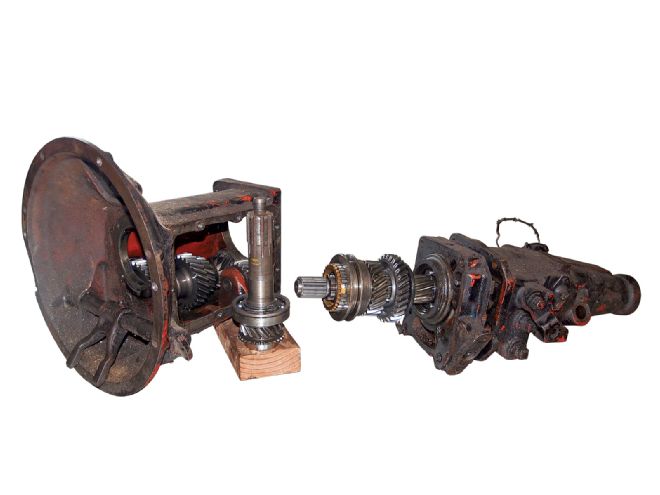 The tailshaft and the overdrive assembly are removed from the transmission case as a unit.
The tailshaft and the overdrive assembly are removed from the transmission case as a unit.
Over the past three years we've had a '49 to early '51 Mercury style overdrive transmission in daily use behind a Flathead in a '31 Ford pickup that has served us well. Recently, we picked up another and decided to freshen it up as the trans in the A was starting to sound as though some bearings had gone as far as they could. We found all the parts we needed from Mac Van Pelt at Van Pelt Sales who specializes in '28-59 Ford transmission parts and repairs. (Van Pelt also authored a book The Ins and Outs of Early Ford Transmissions. That's a must for anyone tearing into one of these gearboxes.)
For an "old-school" rod with three pedals, an overdrive is a great choice and is probably more appropriate than a contemporary five-speed. And if you're building a car that came with an overdrive, don't get in a hurry to replace it. Most likely you'll like it and agree a Borg-Warner overdrive is a great way to get in top gear.